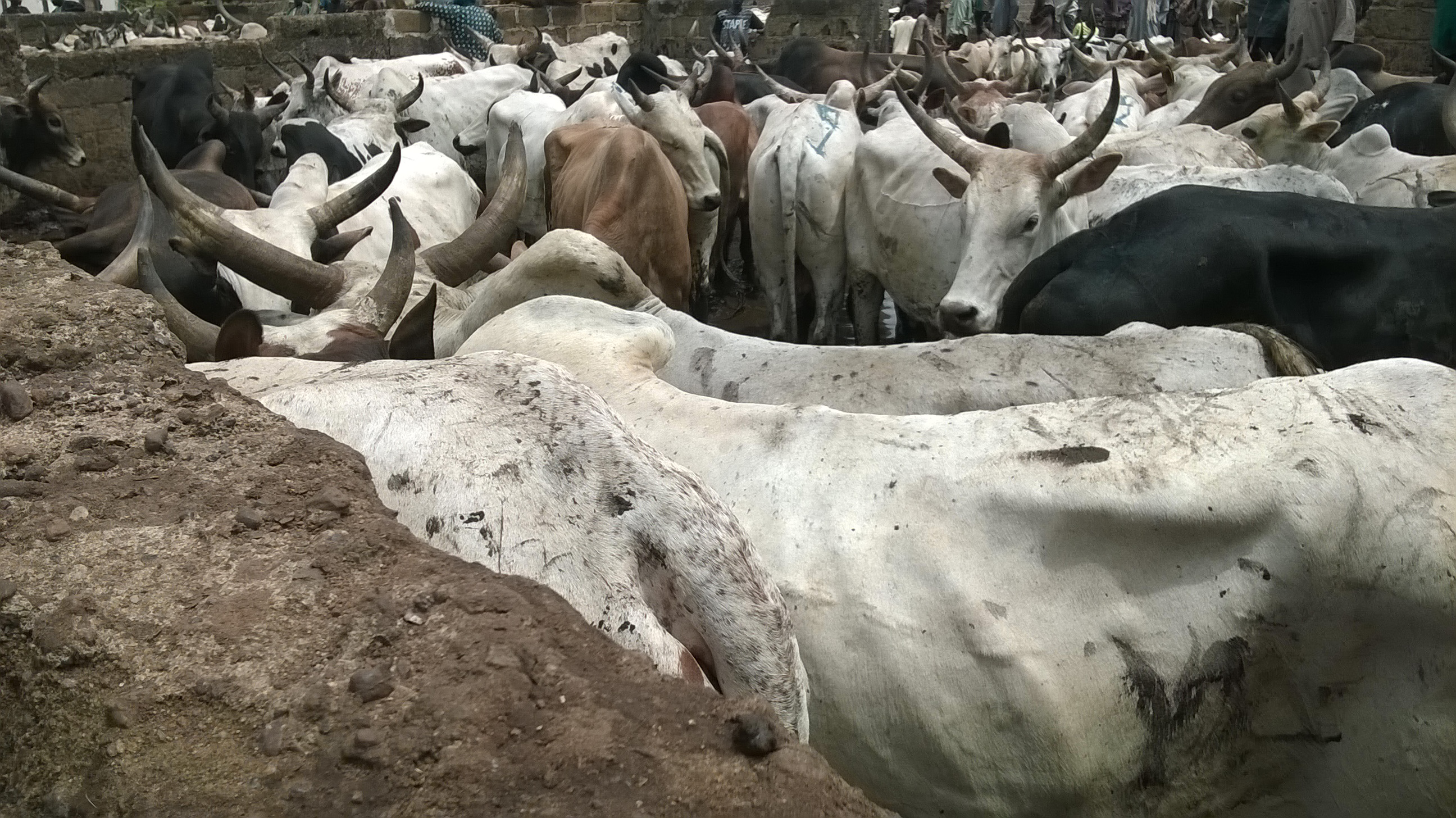
Volunteer Post
Market Value Chains of Small Ruminants
Daniel Miller
My last visit to Mali was in 2013, and there has been significant change since then. In Bamako, construction has progressed rapidly, and outside Bamako, roads are now in good shape and services, along those roads, are much more available. Use of cell phones is ubiquitous and is one of the most important factors responsible for advancing social welfare. Medical care is much more available with clinics and hospitals in all the towns. In the south, trypanosomiasis [disease caused by the Tsetse Fly] is no longer the primary factor restricting livestock production, and has been replaced by nutrition and internal parasites as the primary constraints.
One purpose of this project is to lay the foundations for a future value chain analysis of the marketing of small ruminants, primarily sheep. The goal of the analysis is to augment sale of small ruminants so poor farmers’ standard of living is raised. By determining who the various actors affecting the production and marketing of small ruminants are and what they are doing, changes can be implemented to improve efficiency.

We visited villages around Bamako and Bougouni which are in the semi humid zone. Briefly what we found is that a major problem is mortality of animals before they reach market age. This is a problem in all the villages we visited, but different villages with slightly different management styles appeared to be losing animals for different reasons. In one village their lambs and kids were dying young, probably because they were actively preventing them from nursing colostrum right after birth. In other villages death loss occurred later soon after weaning and appeared to have been due to internal parasites, primarily Haemonchus and Fasciola, although Eimeria (coccidiosis) may also be involved.
In addition to disease, nutrition is also a constraint although not as much. Suboptimal nutrition increases the time until they reach market weight. Small ruminants during the dry season are allowed to wander free in the bush where there is still plenty of browse [woody plants, vines, brush] although little grass. Since the digestive physiology of goats and to a lesser extent sheep is adapted to use browse rather than grass, this is not as problematic as for cattle.

Livestock owners in the villages also cut browse for their animals on a daily basis and there is a small economic component of villagers cutting browse, transporting it on motorcycles and selling it to livestock owners in towns. They also feed kitchen waste – millet and rice – but this is more important for poultry than small ruminants. Some places have rock salt for their livestock, but this practice plus the use of homemade salt/mineral blocks could be expanded. There are several women’s cooperatives in the country making and selling these blocks.
During the growing season the flocks of small ruminants go into the bush to forage, but they are controlled by herders to keep them out of the crops. This has implications for another program, planting improved forage trees, that has a lot of interest. There are a number of species of legume trees that are being introduced worldwide as high protein fodder. Two being used in Mali are Leucaena and Gliciridia. In addition Moringa, a native of India that is claimed to have excellent nutritive properties, is being introduced. The main problem is that they are very palatable, especially Leucaena, so during the dry season when sheep and goats wander unrestricted, they eat the saplings that are planted before they grow out of reach. The villagers commonly ask for advice on how to protect the plants. Leucaena has been used in Mali for decades.
Something that concerns me is that the training that the villagers received in the past was not as comprehensive as it should have been. For example, the use of colostrum is the first principle of neonatal management for transfer of maternal antibodies, but none of the villagers we visited were aware of its importance. They were aware that urea is part of nutritional supplementation, but they did not know why nor were they knowledgeable about its toxicity. It seems that often they were given steps to follow, but without explanation of the reasons for the steps.
The other part of the assignment, study the functioning of the marketplace, raised some contradictions. Before going into the field, we asked about how a farmer sells his animals. We were told that usually the farmer sells them himself at the marketplace, but there are middlemen who will buy the animal for resale and if there are problems, the middleman assumes the risk. In the field at the cattle market in Bougouni we were told that if there is a middleman, he contracts with the farmer as to a price and then sells the animal and gives the farmer the money. The farmer pays a percentage of the price to the middleman. If the middleman gets more for the cow, he keeps the difference plus his percentage. If he cannot get the price, he returns the animal to the farmer. Usually, however, the farmer sells directly to the trucker who takes the bull to Bamako to be butchered.

In a few cases if the bulls are not sold because they are too thin, the owners will trek them to Bamako, grazing along the way and hopefully putting on weight. We did not determine how frequent that is, but it did not seem to be an option for small ruminants.
In Bamako we were told for that for international trade the farmer sells the animal on credit and is paid when the animal is sold to the end buyer. In Bougouni we were told that the farmer is paid on the spot.
The small ruminant market in Bougouni is strictly local with farmers trying to sell only a few animals, fewer than a dozen apiece. With small ruminants there is a marked difference between the local animals and the improved breeds from the north – Chad, Balibalia, Sahel, Sudan. Improved breeds are often sold for breeding rather than slaughter. The buyer pays on the spot or if known to the seller, may offer something as collateral with an agreement to pay the rest later.
Other actors are suppliers of veterinary drugs and nutritional supplements, often the same person. Their use does not appear to be widespread in the villages, but people in towns do purchase them. Vaccines are available for most of the major diseases except fiebre afteuse (FMD, foot and mouth disease). These vaccines are produced at the Central Veterinary Laboratory (LCV) and include blackleg, anthrax, contagious bovine pleuropneumonia, peste de petites ruminants, and pasteurellosis. Programs to encourage farmers to vaccinate regularly have been implemented by various agencies, but have not been notably successful. ILRI has a program that resulted in almost doubling the vaccination rate, but it was still less than half the animals.
As for FMD, at least one village reported that it is a frequent occurrence during the rainy season. It does not occur every year, but often enough to be a major problem. The vaccines come from Botswana where the FMD serotypes (SAT -1, 2, 3, O, A) are different from West Africa serotypes (SAT 2, O, A) and thus are almost useless in preventing Malian FMD. The problems of vaccinating are analogous to influenza in humans in that the vaccine has to be matched to the viral strain causing the outbreak. For future projects the suggestion is to reduce mortality through better education and implement additional channels of sale that would result in a stable marketplace. There are two major markets for sheep and to a much lesser extent goats, Tabaski and daily. Tabaski comes once a year and has important requirements as to ram color and conformation with some importance placed on weight. The rest of the year is either for butchers who are concerned primarily with dressing percentage or baptisms, birthdays, weddings or other celebrations that may have a minor interest in the color, sex and appearance of the animal. Informing the various requirements to the producers with rewards for meeting them would help. While Tabaski requirements are well-known, the quotidian requirements are not regarded as equally important.
Fattening animals is becoming more frequent, especially for women. We did not encounter it much, but the few people who were fattening animals did not seem to be aware of nutritional requirements, especially for protein, minerals and roughage.

The source of animals to fatten are either the market or the producer’s own herd. Buying on the market is riskier because the fattener is unaware of any health problems that may reoccur and a producer is not normal going to sell his best animals for fattening. To be financially successful, the fattener should also have their own source of feed. Buying all inputs cuts margins too thin. Supplements such as oil seed cake or bran, mineral salt, molasses/urea can be purchased, but the main dietary components for energy and protein are better produced by the fatteners themselves.
Suggestions to be studied for their feasibility are planted pastures with inter-seeded legumes (lablab and others) and forage trees such as Leucaena, Gliciridia. and others adapted to Malian conditions. Small ruminant fattening as a sideline to other agricultural processing enterprises producing by-products to be used as feed has been successful in other countries and can be successful here.
Mali is a contrast of tradition and modernism. The farmers do things very traditionally, but when there is some new appropriate technology or procedure that is within their means, they jump on it with both feet. They don’t hold onto the notion “this is the way we’ve always done it.” It makes my work a lot easier.
